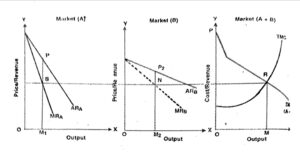Equilibrium under Discriminating Monopoly
Equilibrium under Discriminating Monopoly
Every monopolist aims at maximising his profit. He could achieve his objective at that point where MC=MR. We have to examine how a monopolist decides price discrimination in the different markets. We can apply the theory of simple monopoly firm to more that one market. We shall assume that the discriminating monopolist also seeks to maximise his profit like any simple monopolist. To ensure this he adjusts the output in such a manner as to equate marginal revenue with marginal cost. Assuming two sub-markets A and B he will equalise marginal cost (MC)and marginal revenue (MR) in both the markers to earn maximum profit.
In order to reach the equilibrium position, the discriminating monopolist will have to take three decisions:
- How much output should be produced?
- How to divide total output between two different markets?
- What price should be charged in each market?
Now let us examine these decisions in detail with the help of figure.
How much total output should be produced?
The same marginal principle will guide his decision to produce a total output as that which guides a perfect competitor or a simple monopolist. In other words, the discriminating monopolist will compare the marginal revenue (MR) with the marginal cost (MC) of the output. But he has to find out first the aggregate marginal revenue of the two sub-markets taken together and then compare this aggregate marginal revenue with the marginal cost of the total output.
The composite (combined) marginal revenue curve (ΣMR) is found by adding the marginal revenue curves of Market A and Market B horizontally. The composite marginal revenue curve (combined marginal revenue curve) is represented as EMR or CMR. Fig ‘C’ shows the position of MR curve in the combined market, i.e., A +B. That is why the MR curve is partly steep and partly flat.
Thus monopolist will produces that level of output at which total marginal cost (TMC) is equal to combined marginal revenue (ΣMR).
TMC= (ΣMR)

How to divide total output between two Markets
Once the total output is produced has been determined, the next task for the discriminating monopolist is to distribute the total output between the two sub-markets.
The monopolist will maximize his profits by equating the MC of the whole output with the MR in Market A and MC of the whole output with the MR in Market B.
Fig : ΣMR and TMC of total production are equal at point R. When production is OM (equivalent to OM1+OM2 ) MR and MC are equal. A horizontal line parallel to the OX – axis drawn through point R cuts the marginal revenue curves of market B and A at point N and S respectively. Here both MR, are equal (i.e.,M1S-M2N). Vertical lines drawn through points N and S to meet the OX -axis will provide us the quantity sold in each market in this way the quantity sold is OM, in market – A and OM in Market -B the total of which (i.e., OM1+OM2)will be equivalent to total production OM.
What price should be charged in Each Market
Another important thing to discover is what prices will be charged in the two markets. It is clear from the demand curve (AR) that amount OM1 of goods can be sold at price M₁P1 in sub-markets A. Therefore, price M1P1 will be set in sub-market A. Likewise amount OM₂ can be sold at price M₂P2 in sub-market B. Further, it should be noted that price will be higher in the market-A where the demand is less elastic than in market – B where the demand is more elastic. Thus price M, P, is greater than the price M2P2
In this way:
In Market A, price is P1M1 and quantity sold is OM1
In Market B, price is P₂M₂ and quantity sold is OM2
Total output sold is OM1 + OM₂ – OM.
We can sum up as follows:
- for equilibrium of a discriminating monopolist:
- (A) Marginal cost of total output must be equal to his combined marginal revenue.
TMC = ΣMR
- (B) Marginal revenue in all the sub-markets must equal the combined marginal revenue.
MRA = MRB = ΣMR
- The total output will be distributed for sale in the various markets according to their price elasticities.
- Greater the elasticity of demand for the product in a market, greater the proportion of output sold in it. Greater the inelasticity lesser the proportion of output sold.
- There is an inverse relation between elasticity of demand and price. In a market where demand elasticity is more, price will be low and vice-versa.
Important links
- Perfect Competition- Definition, Equilibrium firm & Conditions
- Equilibrium of an Industry in the short remand Long-Run
- Equilibrium of Monopoly- Short & Long Period Equilibrium
- Dumping- Meaning, Purpose, Price Determination etc.
- Monopoly- Definitions, Features, Classification etc.
Disclaimer: wandofknowledge.com is created only for the purpose of education and knowledge. For any queries, disclaimer is requested to kindly contact us. We assure you we will do our best. We do not support piracy. If in any way it violates the law or there is any problem, please mail us on wandofknowledge539@gmail.com

